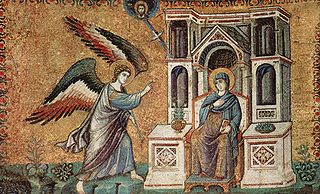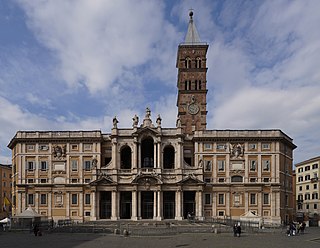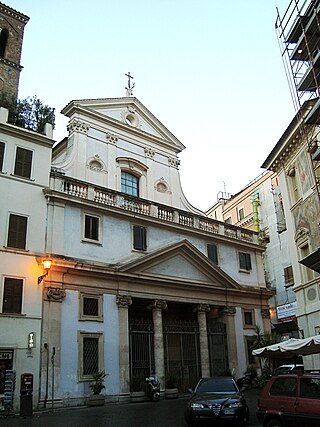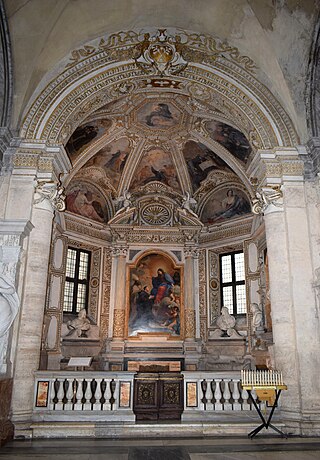
The Apostolic Palace is the official residence of the Pope, the head of the Catholic Church, located in Vatican City. It is also known as the Papal Palace, the Palace of the Vatican and the Vatican Palace. The Vatican itself refers to the building as the Palace of Sixtus V, in honor of Pope Sixtus V, who built most of the present form of the palace.

Pietro Cavallini was an Italian painter and mosaic designer working during the late Middle Ages.

The Basilica of Saint Mary Major, or church of Santa Maria Maggiore, is one of the four major papal basilicas as well as one of the Seven Pilgrim Churches of Rome and the largest Marian church in Rome, Italy. Santa Maria Maggiore is the first Marian sanctuary in the Western world and the mother of all sanctuaries.

Madonna Della Strada or Santa Maria Della Strada is a painting of Mary, mother of Jesus at the Church of the Gesù in Rome, mother church of the Society of Jesus (Jesuits) religious order of the Catholic Church; it is a variation on the basilissa (imperial) type of icon.

Pinturicchio, or Pintoricchio, also known as Benetto di Biagio or Sordicchio, was an Italian Renaissance painter. He acquired his nickname because of his small stature and he used it to sign some of his artworks that were created during the fifteenth and sixteenth centuries.

Santa Maria sopra Minerva is one of the major churches of the Order of Preachers in Rome, Italy. The church's name derives from the fact that the first Christian church structure on the site was built directly over the ruins or foundations of a temple dedicated to the Egyptian goddess Isis, which had been erroneously ascribed to the Greco-Roman goddess Minerva.

The Basilica of Santa Maria in Trastevere or Our Lady in Trastevere is a titular minor basilica in the Trastevere district of Rome, and one of the oldest churches of Rome. The basic floor plan and wall structure of the church date back to the 340s, and much of the structure to 1140–43. The first sanctuary was built in 221 and 227 by Pope Callixtus I and later completed by Pope Julius I. The church has large areas of important mosaics from the late 13th century by Pietro Cavallini.

The Parish Basilica of Santa Maria del Popolo is a titular church and a minor basilica in Rome run by the Augustinian order. It stands on the north side of Piazza del Popolo, one of the most famous squares in the city. The church is hemmed in between the Pincian Hill and Porta del Popolo, one of the gates in the Aurelian Wall as well as the starting point of Via Flaminia, the most important route from the north. Its location made the basilica the first church for the majority of travellers entering the city. The church contains works by several famous artists, such as Raphael, Gian Lorenzo Bernini, Caravaggio, Alessandro Algardi, Pinturicchio, Andrea Bregno, Guillaume de Marcillat and Donato Bramante.

The Church of Saint Susanna at the Baths of Diocletian is a Catholic parish and Cistercian conventual church located on the Quirinal Hill in Rome, Italy. There has been a titular church associated to its site as far back as AD 280. The current church was rebuilt between 1585 to 1603 for a community of Cistercian nuns founded on the site in 1587 and still based there.

Santa Maria Antiqua is a Catholic Marian church in Rome, Italy, built in the 5th century in the Forum Romanum, and for a long time the monumental access to the Palatine imperial palaces.

Sant'Eustachio is a Roman Catholic titular church and minor basilica in Rome, named for the martyr Saint Eustace. It is located on Via di Sant'Eustachio in the rione Sant'Eustachio, a block west of the Pantheon and via della Rotonda, and a block east of Sant'Ivo alla Sapienza and the Via della Dogana Vecchia.

Santi Luca e Martina is a church in Rome, Italy, situated between the Roman Forum and the Forum of Caesar and close to the Arch of Septimus Severus.
Antonio del Duca or Lo Duca was the Sicilian friar whose persistent campaign for an official veneration of the "Seven Angelic Princes" was partly answered in the dedication of Santa Maria degli Angeli e dei Martiri, constructed to the orders of Pope Pius IV within the ruins of the Baths of Diocletian.
During the Middle Ages, Rome was divided into a number of administrative regions, usually numbering between twelve and fourteen, which changed over time.

The Renaissance in Rome occupied a period from the mid-15th to the mid-16th centuries, a period which spawned such masters as Michelangelo and Raphael, who left an indelible mark on Western figurative art. The city had been a magnet for artists wishing to study its classical ruins since the early 15th century. A revived interest in the Classics brought about the first archaeological study of Roman remains by the architect Filippo Brunelleschi and the sculptor Donatello, both Florentines. This inspired a corresponding classicism in painting and sculpture, which manifested itself in the paintings of Masaccio and Uccello. Pisanello and his assistants also frequently took inspiration from ancient remains, but their approach was essentially cataloguing, acquiring a repertoire of models to be exploited later.

Santa Maria delle Grazie alle Fornaci fuori Porta Cavalleggeri is a Baroque style, Roman Catholic parish and titular church located at Piazza di Santa Maria alle Fornaci, south of Vatican City and north of the San Pietro train station in the Aurelio quarter. It was made a cardinalate deaconry by Pope John Paul II on 25 May 1985, and assigned it to Cardinal Duraisamy Simon Lourdusamy, then Prefect of the Congregation for the Oriental Churches. The church became vacant on 2 June 2014 after the death of Cardinal Lourdusamy. On November 11, 2016 it was announced that Mario Zenari will succeed him.

The Mellini or Saint Nicholas of Tolentino Chapel is the third chapel on the left-hand side of the nave in the Church of Santa Maria del Popolo in Rome. The chapel contains several funeral monuments of the members of the Mellini family among them the works of Alessandro Algardi and Pierre-Étienne Monnot.

Santa Lucia in Septisolio was an ancient Roman church with a diaconia. It formerly stood at the base of the Palatine Hill, near the Septizodium of Septimius Severus, from which it took its name. The date of its destruction is not certain, although it seems to have disappeared definitively after the pontificate of Sixtus V (1585–1590).

Santa Maria della Purità was a church in Rome, important for historical and artistic reasons. Consecrated between 1530 and 1538, the building was demolished together with the surrounding district in 1937-40 during the works for the opening of via della Conciliazione.

San Domenico, also called Santa Maria la Grande is a Roman Catholic church and active convent located on piazza San Domenico in the quartiere di Santa Maria la Grande, in Catania, region of Sicily, Italy. The church stands about two blocks north of the church of Sant'Agata la Vetere on via Santa Maddalena. The neoclassical-style, late 17th-century church houses a few prominent altarpieces that survived the 1693 catastrophe in Catania.




















